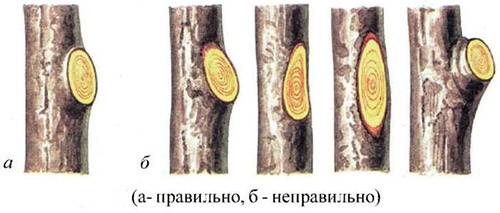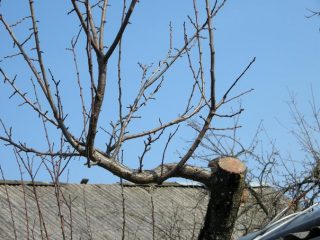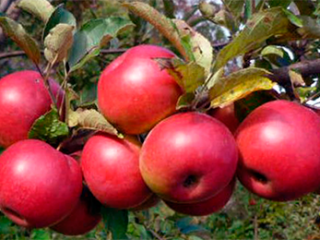Content
The apple tree is the main fruit crop in the countries of the former Soviet Union and occupies about 70% of the area of all orchards. Its wide distribution is due to economic and biological characteristics. The apple tree is durable; there are many varieties that are well adapted for growing and bearing fruit in different climatic zones. Even in Siberia it is cultivated in shale form. We can talk endlessly about the benefits of apples and their culinary properties.
But in order for the tree to bear fruit well from year to year, it needs to be looked after properly. The list of necessary measures for maintaining apple orchards includes fertilizing, watering, constant moisture replenishment for the winter, complex treatments against pests and diseases, mandatory crown formation and pruning. For some reason, the latest events scare inexperienced gardeners the most. Today we will look at apple tree pruning in the fall for beginners.
Why prune apple trees?
It is not so rare to come across apple trees that the owners “pity” and do not prune, and then are surprised that the harvest is poor. In the end, in order for the tree to bear fruit normally, large branches have to be removed, causing sensitive wounds to it. Pruning is a mandatory activity; it is best to do it from the moment the apple tree is planted. Its purpose is:
- formation of a crown of the correct shape;
- tree height regulation;
- strengthening branches;
- regulation of fruiting;
- ensuring optimal crown lighting;
- improving fruit quality;
- removal of old, diseased, unproductive branches;
- facilitating tree care and harvesting;
- increasing the lifespan and fruiting of apple trees;
- rejuvenation of old trees;
- increasing winter hardiness.
If you do not prune, the apple tree may bloom profusely every year, but the harvest will be meager or consist of a large number of small fruits. Without access to sunlight, they will not be filled with sweetness, and thickened branches will become a breeding ground for pests or diseases. The apple tree will spend all its energy on developing useless shoots.
The diagram we propose shows the structure of an adult tree.
When to prune apple trees
It is believed that it is best to prune fruit trees in the spring, before the sap begins to flow. There is no other option for cherries, plums, apricots or other stone fruits. But pome trees - apple and pear - can be pruned in the fall. This is even preferable, because spring, especially in the southern regions, can come suddenly, and you simply do not have enough time to remove branches.
In winter, fruit trees are pruned only by professionals in large gardens - they have no other choice due to the large amount of work. It’s better for beginners not to even try this.After the onset of frost, the bark around the cut site often peels off, freezes and takes a long time to heal. It is even possible for the wood to crack, especially after heavy fruiting or a dry summer. It is easier to perform all necessary operations at a positive temperature.
You can prune apple trees in the fall in all regions. In hot or temperate climates, this is done after leaf fall. In the northern regions, it is better to start pruning in September - early October, after harvesting, so that the tree has time to heal its wounds before the onset of frost. It turns out that late varieties in cold climates will have to be tended in the spring.
Apple tree pruning
There are many ways to form the crown of apple trees, for example:
- sparsely tiered;
- lobed;
- fusiform (spindlebush);
- oblique palmette;
- horizontal (Hungarian) palmette;
- Taganrog boat.
In order not to scare novice gardeners, we will tell you the principles that give an idea of how to prune and shape apple trees. This will allow you to grow a healthy, regularly fruiting tree and fill your hand. As you gain skills, pruning techniques will improve.
Methods for pruning an apple tree
When pruning fruit trees, there are two main methods:
- shortening - cutting off part of the branches;
- thinning is their complete removal.
Any shortening activates growth and branching. With severe pruning, 3-4 strong young shoots usually grow. Weak causes the development of fewer short branches. Thinning – lightens the crown, makes it possible for existing shoots to gain strength and bear fruit normally.
Apple tree pruning level
In practice, there are three degrees of pruning of fruit trees:
- Strong, when 50-60% of the annual growth is shortened by more than half the length. The remaining overgrown branches are removed to the ring. Usually, after severe pruning, a large number of vertically directed fatty shoots (tops) grow.
- With moderate pruning, 40-50% of young branches are shortened by a third or half the length, and the same amount is cut into a ring. The result will be the absence of tops and normal growth.
- Short pruning - shortening 20-30% of young branches by 1/5-1/4 of the length and completely removing a third of the growth. At the end of next year, the shoots will lengthen by only 5-10 cm.
Well-groomed mature apple trees that have received sufficient moisture during the growing season are pruned lightly or moderately. Neglected trees need to remove a large number of branches.
Types of apple tree pruning
There are the following types of pruning apple trees:
- Formative. It begins in the first years of the apple tree’s life and continues for several years. Its purpose is to form a frame of the required shape from the skeletal branches (first order and leader).
- Regulating fruiting. Provides a balance between branch growth and yield.
- Sanitary. Provides removal of dry, diseased, broken shoots.
- Restorative. Restores the crown of a tree after severe frostbite or mechanical damage.
- Rejuvenating. Designed to prevent cessation of growth or fruiting. In very old apple trees, the growing season can resume.
In fact, annual pruning, which is often called maintenance, combines all of the above methods. For young apple tree it is more formative, an old tree is rejuvenated to the best of its ability, and in an adult tree, fruiting is regulated.
Required Tools
In order to prune apple trees, you will need:
- pruning shears with a ratcheting mechanism - for trimming branches thicker than 2 cm in diameter;
- regular pruning shears - for trimming thin shoots;
- pruning shears with long handles - for trimming high branches;
- garden saw - for cutting thick branches that cannot be cut with pruning shears;
- garden knife - for stripping wood or bark.
Sections not exceeding 1 cm in diameter are usually not treated with anything. The wound surface of a large area is covered with a mixture of mullein and clay or oil paint. If you removed a thick skeletal branch from a tree, it will have to be processed in the spring and autumn until it is overgrown.
Apple tree pruning technique
Depending on the thickness of the branch and the purpose of its removal or shortening, pruning into a bud, a ring, or a side branch is distinguished. Let's get to know them in more detail.
Pruning an apple tree
To give the shoot the desired direction of growth, it is shortened to a bud, which must be located on the outside of the branch. The cut should be made at an angle of 45 degrees. It should not be located too close to the bud, so as not to damage it, but the stump left should not be longer than 1 cm.
Pruning an apple tree into a ring
A ring is a woody influx at the base of a thick branch. To remove it, a cut is made along the outer edge. Over time, it will be covered with bark, and we will not cause much damage to the tree. If you make a cut close to the trunk, touching the ring, the wound surface will heal poorly, perhaps a hollow or shell will form there. This will not benefit the apple tree, just like leaving a stump, the bark of which will peel off and the wood will rot.
Before removing a thick branch, be sure to make a small cut at the bottom of the ring before cutting all the way down. Thus, it will not collapse under its own weight, breaking off the bark and injuring the trunk. Clean the cut with a garden knife so that the swelling forms faster, treat the wound surface with oil paint or a mixture of mullein and clay.
Watch a video detailing the removal of thick apple tree branches:
Pruning an apple tree to a side branch
If two branches grow from the same place, that is, they form a fork, and one of them needs to be removed, pruning is done to a side branch (for translation). Depending on the thickness, a pruner or saw is used, and a wound surface with a diameter of more than 1 cm is treated.
How to prune an apple tree
A young, newly planted apple tree is pruned differently from an adult fruit-bearing or old one. We will look at how to carry out this operation in the fall for beginners, depending on the age of the tree.
Pruning an apple tree when planting
Shorten the apple tree to a height of 90 cm, and the side branches (if any) by 2/3. Remove all shoots below 40 cm completely. This is done in order to subsequently form an apple tree that will be easy to care for. As the trunk grows, it will stretch out, and the lower branches will be just at the right height to make it convenient to walk or harvest.
Pruning a 3-5 year old apple tree
After the tree takes root well and spends 2-3 years on your site, you need to start forming a crown. Please note that branches directed vertically upwards produce almost no harvest. Most fruits ripen on shoots located almost parallel to the ground level.
As skeletal branches, leave 3-4 of the strongest ones, growing horizontally and looking in different directions. Cut the remaining shoots into a ring. If you have already formed a second tier, do the same. Now trim 1/3 of the skeletal branches to the outer bud.
Pruning a fruiting apple tree
First, trim off any broken, dead or diseased branches. Then remove the tops - shoots that go vertically upward will not bear fruit anyway. Now look carefully at the tree and cut out the weak branches directed into the crown, crossing each other. Shorten the remaining shoots. The apple tree must be well lit and ventilated, only then will it produce a good harvest.
Pruning an old apple tree
Old fruit-bearing apple trees are pruned as described above. The difference is that the time has come to change the skeletal branches that are unpromising, that is, those that have practically stopped producing crops. They are removed one by one, but not into a ring, but leaving a small stump cut at an angle of 45 degrees.
The grown tops are removed, leaving 1-2 of the best. Using twine, they are gradually bent, moving them to a horizontal plane, and new skeletal branches are formed by pruning.
Sometimes we have an old apple tree growing on our site that practically doesn’t bear fruit anymore, but it’s a shame to lose the variety, and it’s a good place. You can cut off the entire trunk of a tree at an angle of 45 degrees, and form a new crown from the branches that have grown around it.
The video we offer for viewing for beginner gardeners will help you make the correct pruning and avoid many mistakes:
Conclusion
Of course, pruning apple trees is not the easiest operation. But in order to get a decent harvest, it is simply necessary.



























